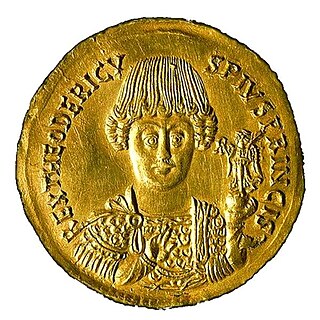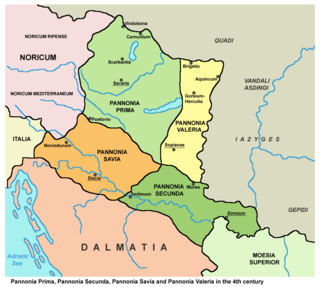 W
WThe Diocese of Pannonia, from 395 known as the Diocese of Illyricum, was a diocese of the Late Roman Empire. The seat of the vicarius was Sirmium.
 W
WIllyricum was a Roman province that existed from 27 BC to sometime during the reign of Vespasian. The province comprised Illyria/Dalmatia and Pannonia. Illyria included the area along the east coast of the Adriatic Sea and its inland mountains. With the creation of this province it came to be called Dalmatia. It was in the south, while Pannonia was in the north. Illyria/Dalmatia stretched from the River Drin to Istria (Croatia) and the River Sava in the north. The area roughly corresponded to modern northern Slovenia, Serbia, Albania, Montenegro, Bosnia and Herzegovina and coastal Croatia. Pannonia was the plain which lies to its north, from the mountains of Illyria/Dalmatia to the westward bend of the River Danube, and included modern Vojvodina, northern Croatia and western Hungary. As the province developed, Salona became its capital.
 W
WNoricum is the Latin name for the Celtic kingdom or federation of tribes that included most of modern Austria and part of Slovenia. In the first century AD, it became a province of the Roman Empire. Its borders were the Danube to the north, Raetia and Vindelicia to the west, Pannonia to the east and southeast, and Italia to the south. The kingdom was founded around 400 BC, and had its capital at the royal residence at Virunum on the Magdalensberg.
 W
WThe Ostrogothic Kingdom, officially the Kingdom of Italy, was established by the Germanic Ostrogoths in Italy and neighbouring areas from 493 to 553.
 W
WPannonia was a province of the Roman Empire bounded on the north and east by the Danube, coterminous westward with Noricum and upper Italy, and southward with Dalmatia and upper Moesia. Pannonia was located in the territory of present-day western Hungary, eastern Austria, northern Croatia, north-western Serbia, northern Slovenia and northern Bosnia and Herzegovina.
 W
WPannonia Prima was an ancient Roman province. It was formed in the year 296, during the reign of Emperor Diocletian. Previously, it was a part of the province of Pannonia Superior, which, along with Pannonia Inferior, was gradually divided into four administrative units: Pannonia Prima, Pannonia Secunda, Valeria, and Savia. This transition was completed by the time of Constantine. According to the Notitia Dignitatum, Pannonia Prima was governed by a Praeses.
 W
WPannonia Savia or simply Savia, also known as Pannonia Ripariensis, was a Late Roman province. It was formed in the year 295, during the tetrarchy reform of Roman emperor Diocletian, and assigned to the civil diocese of Pannonia, which was attached in the fourth century to the Praetorian prefecture of Illyricum, and later to the Praetorian prefecture of Italy.
 W
WPannonia Superior, lit. Upper Pannonia, was a province of the Roman Empire. Its capital was Carnuntum. It was one on the border provinces on the Danube. It was formed in the year 103 AD by Emperor Trajan who divided the former province of Pannonia into two parts: Pannonia Superior and Pannonia Inferior. The province included parts of present-day states of Austria, Croatia, Hungary, Slovakia, and Slovenia.
 W
WThe praetorian prefecture of Illyricum was one of four praetorian prefectures into which the Late Roman Empire was divided.